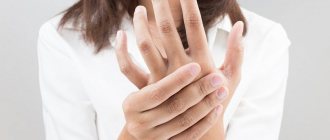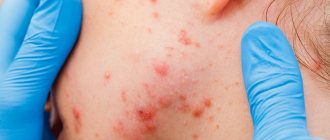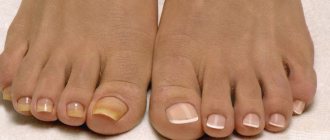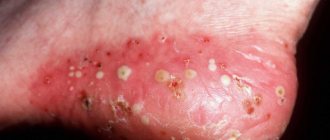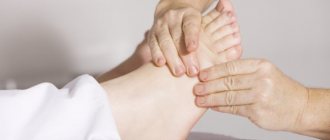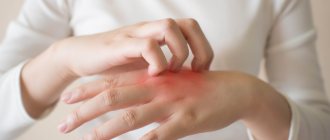July 29, 2020
Vulgar psoriasis is also called simple, ordinary. This is the most common form of the disease with the classic presentation of reddish, round plaques throughout the body. These plaques are slightly raised above the skin, tend to merge, and are covered on top with a whitish coating of small dry skin flakes.
Psoriatic plaques cause psychological and physical discomfort to the patient, as they can be perceived by others as a sign of an infectious disease, cause itching and can even bleed when injured.
Since this dermatological disease is autoimmune in nature, treating psoriasis vulgaris is a complex and lifelong task. In this case, not only correct recommendations from the doctor are required, but also lifestyle adjustments by the patient himself.
Treatment of vulgar psoriasis in the clinic
Psoriasis vulgaris, like any type, is a chronic disease from which a complete cure is impossible.
The goal of treatment is to alleviate the patient’s condition and achieve stable remission. This can be done using an integrated approach that combines local treatment and physiotherapy. In this case, inpatient observation is not required; outpatient treatment is sufficient. The exceptions are:
- Extremely severe course of the disease;
- Presence of symptoms of intoxication;
- Disturbances in the functioning of a number of organs and systems of the body;
- Lack of positive results from outpatient treatment.
The treatment program is individual in each case. The selection of therapeutic measures is carried out taking into account the stage of development of vulgar psoriasis, the patient’s age and his general condition.
Risk factors
- Heredity.
- Violation of lipid metabolism in the body.
- Disturbances of the endocrine system.
- Infectious diseases
- Stress, depression, nervous disorders and shocks.
Red spots on the skin after stress
Diagnosis of skin diseases
Risk factors that provoke the manifestation of vulgar psoriasis also include mechanical trauma to the skin, taking a number of medications, atherosclerosis and diabetes.
How is mild psoriasis vulgaris treated?
Vulgar psoriasis, the treatment of which is carried out in the early stages, allows one to limit oneself to the use of external agents: ointments, gels, and in some cases, plant tinctures. The ointments contain components of salicylic acid and tar. Their main effect is to slow down inflammatory processes in the layers of the skin and prevent the appearance of new scales.
Sometimes therapy is carried out using drugs related to vitamin D. They affect the metabolism in cells, which reduces the rate of their division. This allows you to eliminate skin peeling, inflammation and other disorders.
In exceptional cases, when the effect of these drugs is not observed, corticosteroid hormonal drugs are indicated. These are betamethasone, hydrocortisone, clobetasol and the like ointments. As a result of their use, the process of cell reproduction slows down, which also leads to the cessation of the inflammatory process. Along with the main effect, these drugs have a list of side effects, so their use is recommended only under medical supervision.
Prevention
As we have already said, psoriasis vulgaris is a chronic disease that cannot be cured completely, but you can stop the symptoms and make the disease go into remission for a long time.
The main rule for the prevention of psoriasis is a fighting spirit and attentive attitude towards yourself. Important preventive measures for the disease also include:
- rejection of bad habits;
- regular walks in the fresh air, moderate physical activity;
- proper nutrition;
- adherence to daily routine;
- proper sleep, proper rest;
- elimination of stress and strong feelings.
Only a sensitive attitude towards yourself and your health will allow patients, even with advanced forms of vulgar psoriasis, to forget about their illness for a long time and return to a full life.
We hope that our recommendations for the treatment of vulgar psoriasis will be useful to you. Consult your dermatologist about Rederm ointment for psoriasis flare-ups. This product, based on a combination of betamethasone and salicylic acid, has anti-inflammatory, antipruritic, antiallergic and keratolytic effects on the skin.
Treatment of moderate form of vulgar psoriasis
Vulgar progressive psoriasis requires the use of both anti-inflammatory and detoxification drugs. To do this, intravenous injections of a solution of calcium gluconate, sodium thiosulfate or magnesium sulfate are added to the course of external treatment. The average course length is 10 injections.
If psoriasis is accompanied by severe itching, antihistamines are prescribed: suprastin, tavegil, clemastine. The duration and frequency of administration is determined by the attending physician. In most cases, this is a two- or three-time dose for 10 days.
At the stage of regressive psoriasis, it is necessary to use highly concentrated external preparations with a resolving and exfoliating effect. The leather is treated with birch tar or dithranol according to the instructions for 2-4 weeks. Birch tar is also applicable in milder stages of vulgar psoriasis, and dithranol is indicated only for regressive disease. In addition to these agents, calcipotriol, naftalan oil, and 2-10% salicylic acid are used.
It is mandatory for the treatment of psoriasis to be prescribed drugs that increase the level of immunity, metabolic rate and blood circulation in the vessels located in the skin.
Home treatment
Homemade psoriasis treatment recipes based on natural foods and herbs can be an effective complement to drug treatment for psoriasis. However, before using one or another method of treating a disease, the patient must agree it with the attending physician.
The most popular folk recipes for the treatment of psoriasis are the following:
- Decoction of 5 herbs. For oral administration, a product is prepared based on plants that have anti-inflammatory, anti-allergenic, wound-healing and antimicrobial effects. As a rule, mix a tablespoon of dry herbs of nettle, string, yarrow, St. John's wort and celandine. The mixture must be poured into a liter of boiling water and boiled for 10-15 minutes, and then taken orally three times a day.
- Tar-based ointment will help quickly and gently cleanse the skin. To prepare it, 200 grams of pine tar must be mixed with two tablespoons of camphor oil, and then add 30 grams of grease. Be sure to mix all the ingredients thoroughly and apply to the plaques up to 3 times a day. Typically, the course of treatment continues until the skin is completely cleared of plaques.
Physiotherapy for vulgar psoriasis
If vulgar psoriasis of any form, including severe, is diagnosed, patients are indicated for therapy with medium-wave or narrow-band UV radiation. The course of such physiotherapy is 15-25 sessions. Their number depends on the type of exposure - treatment with narrow-band rays requires more procedures than therapy with medium-wave exposure.
PUVA therapy, no less often prescribed to patients with psoriasis, is UV irradiation supplemented with a photoactive substance. It is taken internally 2-3 hours before the start of the procedure.
For extensive lesions, selective UV therapy is considered the optimal treatment option. The essence of this technique is the simultaneous exposure to ultraviolet rays of different lengths and properties. This allows you to cover as many skin cells as possible with different depths of damage.
Psoriasis, including vulgar psoriasis, in severe cases with pronounced malignant properties, requires, as an addition to physiotherapy, the use of drugs to suppress the division of malignant cells.
Other methods of physiotherapy also provide good results. This is how psoriasis is treated with laser therapy. An individually tuned device emits a laser beam that affects only the affected areas of the skin. Its contact with healthy areas of the skin does not affect them in any way, which makes the procedure as accurate and effective as possible.
The duration of the course of laser procedures and their number, as in other cases, are selected individually. Not only the age and condition of the patient’s skin matters, but also its type, thickness, color and other characteristics. Laser therapy is not applicable to very dark skin, regardless of the stage of development of psoriasis.
In addition to these methods, for vulgar psoriasis the following is prescribed:
- Chemophototherapy;
- Balneotherapy;
- Mud therapy;
- Sulfide and radon baths;
- Vacuum therapy;
- Magnetic-vacuum herbal medicine;
Any given method of physiotherapy is aimed at restoring natural metabolism in the skin layers, ridding them and the entire body of toxins. It is also important to cleanse the skin of dying cells and enhance its regenerative properties. In addition, physiotherapy has a beneficial effect on the functioning of the nervous system, disruptions in which are often accompanied by psoriasis.
Symptoms of plaque psoriasis
The onset of the disease is characterized by the appearance of small local rashes, the color of which varies from pale pink to bright red. If the patient does not consult a doctor in a timely manner and does not receive proper treatment, the size of the rashes increases, they connect with each other, forming more extensive lesions of the skin.
Psoriatic tumors stand out quite strongly against the background of healthy skin. And not only due to their color, in the places where they occur, the skin rises above the rest of the surface, the plaques themselves take the shape of an uneven ring. When scraped with a scalpel, characteristic signs of vulgar psoriasis are revealed:
- “stearic stain” - manifests itself in the form of increased silvery-white peeling;
- “terminal film” - after scraping with a scalpel, a perfectly smooth surface is formed;
- “blood dew” - after scraping off the last layer of scales, blood immediately begins to ooze in the form of drops;
- a few months after the plaques appear, they stop growing, stop peeling and practically disappear. But in their place, depigmented or hyperpigmented spots may remain.
Psoriasis of any localization can spread throughout the body, so do not delay treatment.
See how easily the disease can be cured in 10-12 sessions.
Diet for vulgar type psoriasis
As with many skin pathologies, patients suffering from vulgar psoriasis are advised to follow a low-calorie, low-fat diet. You should completely exclude from the menu foods that increase the tendency to inflammation: cheeses, full-fat milk and its derivatives, animal fat, carbonated drinks, smoked and fried foods, hot spices, canned food with vinegar, butter and confectionery, as well as strong coffee and tea.
Most of the menu should consist of dishes that maintain the concentration of alkali. Among them are vegetables, with the exception of the nightshade family, beans, cabbage and pumpkin, fruits, except prunes.
About 30% of the diet should be allocated to foods that provide an acidic environment: lean meat and milk, bread. It is imperative to supplement your daily diet with B vitamins, as well as E, C, A, P, D to improve cellular metabolism and overall health.
Attention!
This article is posted for informational purposes only and under no circumstances constitutes scientific material or medical advice and should not serve as a substitute for an in-person consultation with a professional physician.
For diagnostics, diagnosis and treatment, contact qualified doctors! Number of reads: 839 Date of publication: 09/11/2018
Dermatologists - search service and appointment with dermatologists in Moscow
Psoriasis: clinical and therapeutic aspects
P
soriasis is a chronic recurrent dermatosis of a multifactorial nature, characterized by a rash of profusely scaly epidermo-dermal papules on the skin. With psoriasis, joints, as well as various organs and systems of the body, may be involved in the process. In various countries, psoriasis affects 1 to 3% of the population. This disease is rare among Eskimos, Japanese and West Africans, and extremely rare among North American and South American Indians. Men and women get sick equally often. The disease can begin at any age.
Heredity factor
– one of the most significant in the development of psoriatic disease. If one of the parents is sick, the risk of psoriasis in the child is 8%; if the father and mother suffer from psoriasis – 41%. The mode of inheritance is probably polygenic. HLA class I is often detected in patients: HLA-B13, HLA-B17, HLA-Bw57, HLA-Cw6.
Depending on the age at which the disease began, psoriasis is divided into 2 types
. Although psoriasis can begin at any age, there are two age peaks when the onset of the disease is most likely. The first is in adolescence and young adults (from 16 to 25 years old), and the second is in older people (from 50 to 60 years old). The first type includes patients who become ill at a young age. It was noted that in people of this group the hereditary nature of the disease is more often traced, the rashes are more widespread, and in a greater percentage of cases joint damage is associated. Patients in the second group have a more favorable course of the disease.
In pathogenesis
In psoriatic disease, the leading role belongs to a genetically determined disorder of keratinization caused by hyperproliferation and impaired differentiation of keratinocytes. In psoriasis, violations of almost all parts of the immune regulation of the skin have been identified, leading to the release of various mediators of the immune response and inflammation by activated keratinocytes, lymphocytes, macrophages and resident cells of the dermis: polyamines, proteases, cytokines. They stimulate the proliferation of defective keratinocytes and the development of inflammatory changes in the skin, including infiltration of the dermis and epidermis with polymorphonuclear and mononuclear leukocytes.
Clinical picture
The most common is the so-called vulgar (ordinary) psoriasis.
. It is characterized by rashes of flat papules, slightly raised above the surface of apparently healthy skin, with clear boundaries, pink-red color, rounded outlines, prone to merging into plaques. The surface of the rash elements is covered with small silvery-white scales that easily fall off when scraped. The size of the rashes varies from a few millimeters to the size of a palm or more. The rash may spontaneously regress without a trace after weeks, months or years.
Gypsum psoriasis.
Vulgar psoriasis.
Psoriatic erythroderma.
Exudative psoriasis.
The most common localization of rashes is on the elbows, knees, legs, buttocks, scalp and areas of local trauma (Koebner phenomenon). With psoriasis, nail damage can often be observed, sometimes isolated. There are three forms of psoriatic nail damage: hypertrophic, dystrophic and atrophic.
Histologically, psoriasis vulgaris is characterized by pathological hyperproliferation of the epidermis and inflammation of the epidermis and dermis. In psoriasis lesions, a large number of mitotic figures are found in the basal layer, acanthosis, hyper- and parakeratosis, agranulosis (absence or thinning of the granular layer). The proliferative activity of the psoriatic epidermis is many times higher than usual, the migration of keratinocytes from the basal layer to the surface of the epidermis is faster, and the duration of the cell cycle of keratinocytes is shortened from 28 days normally to 3–4 days.
Exudative psoriasis
occurs less frequently than vulgar. This is a more severe form of the disease. As a result of impregnation with exudate, psoriatic elements are covered with grayish-yellow crusty scales. In rare cases, with this form of psoriasis, exudation is so pronounced that cavitary elements appear on the skin. The rashes are accompanied by itching and may become covered with purulent-hemorrhagic crusts. Exudative psoriasis is sometimes widespread and can be combined with other forms, for example, psoriatic arthritis. In a number of patients, exudation phenomena are transient, and after their resolution, the psoriatic process acquires typical features.
Pustular forms are becoming more common
psoriasis, also characterized by a severe course: palmoplantar pustular psoriasis (Barber type), generalized pustular psoriasis (Zumbusch type) and pustular psoriasis, which occurs as a centrifugal annular erythema.
The most severe form of psoriatic disease is psoriatic erythroderma
. Most often, it develops as a result of irrational therapy that does not correspond to the stage of psoriasis. This is facilitated by intense insolation, the use of tar preparations in the progressive stage of the disease, irrational use of methotrexate or steroid hormones, etc. Strong emotional experiences can also provoke erythroderma.
As a result of the fusion of large plaques into continuous diffuse lesions in psoriatic erythroderma, the entire skin or its large areas are involved in the process (partial erythroderma). The skin is hyperemic and infiltrated. Peeling is pronounced, the scales can be typical for psoriasis - small, silvery-white or lamellar, large lamellar. The facial skin of such patients is tight, and the lower eyelids of some patients are ectropic. Lymph nodes are usually enlarged. Patients complain of chills, a feeling of skin tightness, itching and burning.
In some patients with psoriasis, the joints are involved in the process - psoriatic arthropathy
or arthropathic psoriasis. The severity of psoriatic arthropathy often determines the prognosis of the disease, because involvement of joints in the process often leads to disability. Initially, the process involves small joints of the hands and/or feet, hip, sacroiliac joints, then (without a specific sequence) large joints of the limbs and torso. Arthralgia intensifies with movement and is characterized by varying intensities: the pain can be weak, quickly passing, or it can be intense and continuous. Soreness is noted not only in the joints, but also in the muscles. The skin in the area of the affected joints is swollen, hyperemic, and the tissue temperature is elevated. There is limited mobility. In a number of patients, more or less pronounced symptoms of osteoporosis can be observed. Bone changes are irreversible. The severe course of psoriatic arthritis is accompanied by general phenomena: temperature reaction, malaise, headache, etc. If the course is unfavorable, the process leads to severe deformation, contractures, and ankylosis.
| Psoriatic erythroderma most often develops due to irrational therapy that does not correspond to the stage of psoriasis. |
As manifestations of the systemic nature of the process in psoriasis, one can see the phenomena of nephropathy, dysfunction of the liver and gastrointestinal tract, and the cardiovascular system.
An objective indicator of the process is PASI - lesion severity index
, which is calculated taking into account the size of the affected area, the severity of hyperemia, infiltration and peeling. Maximum PASI index – 72; mild, moderate and severe forms of psoriasis are defined by numbers: 0–10, 10–50, 50 or more, respectively.
During psoriasis there are 3 stages
: progression stage, stationary stage and regression stage. The first stage is characterized by the appearance of new elements, their growth and fusion into large plaques. The rashes at this stage are not completely covered with scales - a zone free of scales remains along the periphery, indicating the growth of elements. In the second stage, new rashes are usually not noted; the elements are completely covered with scales, which indicates the cessation of their growth. At the end of this stage, with side lighting, a narrow rim of pseudoatrophy (Voronov's rim) can be seen around the elements. In the regression stage, hyperemia and infiltration decrease, the elements become thinner, freed from scales and gradually completely resolve, leaving areas of temporary hyperpigmentation.
Treatment tactics
Therapeutic tactics depend on the stage of the process, as well as the characteristics of the course of the disease in each individual patient. When choosing a treatment method, it is necessary to take into account the prevalence of the process, its clinical form, the presence of visceral pathology, as well as laboratory examination data. Therapeutic and preventive measures should be aimed not only at eliminating this exacerbation of the disease, but also at reducing the frequency of relapses, maximizing the prolongation of remissions, preventing complications, and social rehabilitation of the patient.
In case of mild psoriasis, which is limited in nature, or in the presence of single “standby” plaques, external treatment, balneo- and spa therapy, adherence to diet, work and rest are often sufficient.
Moderate and severe forms of the disease require complex treatment on an outpatient basis, and in the period of exacerbation of symptoms - treatment in a hospital setting. In order to prolong remission, courses of anti-relapse therapy (vitamins, biostimulants, physiotherapy) should be carried out.
Hydrating agents are often used in the treatment of psoriasis.
, softening the flaky surface of psoriatic elements: lanolin-based creams with vitamin supplements, Unna cream, Psoriaten ointment, which, in addition to a softening effect, also has an anti-inflammatory and antiproliferative effect.
In approximately 35% of patients, itching, soreness, redness, and peeling decrease after using these medications. An ointment containing salicylic acid (2 to 5 percent) is the most widely used keratolytic agent. It is used either alone or in combination with coal tar, tar or topical corticosteroids. Ointments with salicylic acid
soften the flaky layers of psoriatic plaques and accelerate their resolution. They also enhance the effects of topical corticosteroids or coal tar by enhancing their adsorption.
Starting from the second stage, anthralin
(cygnoline, dithranol) is one of the most popular topical treatments for psoriasis in many European and some American centers. The mechanism of action of anthralin is to inhibit the synthesis of nuclear and mitochondrial DNA, as well as to slow down the activity of cellular enzymes, polyamines and phosphorylation processes, resulting in a decrease in cell proliferation. Anthralin is applied for 1 hour and then quickly washed off, penetrating only into the affected skin, without loss of effectiveness. This regimen is as effective as the traditional overnight regimen and can be as effective as topical corticosteroids.
Tar preparations are also effective starting from the second stage
, the action of which is based on its keratoplasty, anti-inflammatory and antipruritic effects. Despite the fact that preparations containing tar or coal tar help clear the skin of psoriatic rashes when used independently, they are sometimes used in combination with ultraviolet phototherapy. The use of these products is limited due to the unpleasant odor and the fact that sometimes even in low concentrations they can cause irritation or acne-like rashes on the skin. Coal tar and tar are often used in medicated shampoos to prevent or reduce flaking of the scalp. Tar preparations are contraindicated for exudative psoriasis and kidney diseases.
Corticosteroid ointments are often used to treat psoriasis.
. Potent local corticosteroids act as quickly or faster than tar preparations or anthralin, but are much more convenient for everyday use for patients, since they are odorless, do not cause skin irritation and stains on the body and clothing.
The effectiveness of topical corticosteroid therapy can be enhanced by applying ointment under a tight-fitting plastic film, but at the expense of increased local and systemic side effects. There is currently no convincing evidence that the relationship between the effectiveness of any topical corticosteroid drug and its local or systemic side effects can be disrupted. For psoriasis, preference is given to creams and ointments containing, in addition to steroid hormones, salicylic acid (diprosalik, belosalik, lorinden A), tar (locacorten Tar, lorinden T). In areas with the most delicate epidermis and in children, the use of non-halogenated corticosteroids (Advantan) is recommended.
Irrational therapy with corticosteroid ointments can lead to the transition of psoriatic disease to a more severe form that is difficult to treat (pustular form, psoriatic erythroderma), cause thinning of the skin, the appearance of areas of atrophy, sluggish local infections, hypopigmentation and tachyphylaxis (decreased effect).
The most commonly used non-steroidal external treatment for psoriasis is psorcutan ointment, which contains calcipotriol.
– vitamin D derivative for topical use. This is an analogue of vitamin D3, which has minimal effect on calcium metabolism. The effectiveness of calcipotriol ointment in patients with plaque psoriasis is similar to that of a weak to moderate strength corticosteroid ointment such as betamethasone valerate 0.1%. The ointment is colorless and does not stain clothes, but sometimes its use causes irritation of the facial skin.
Vitamins are widely used in the treatment of psoriasis
group B (B1, B2, B6, B12), ascorbic acid, folic acid, vitamins A, E, PP.
Psychotropic drugs
(tranquilizers, antidepressants, neuroleptics) are an important adjuvant for the treatment of patients with psoriasis whose psychosomatic status contains elements of asthenia and neuroticism. It is desirable that the correction of these conditions be carried out with the participation of a neuropsychiatrist.
To detoxify the body, enterosorbents
(activated carbon, polyphepan, enterosgel, etc.).
Their use is especially indicated for patients with psoriasis with concomitant gastrointestinal pathology. It is recommended to prescribe enzyme preparations
during or after meals and
hepatoprotectors
.
Phospholipid drug Essliver Forte
has a hepatoprotective and epidermis-directed effect. Essliver Forte contains essential phospholipids (phosphatidylcholine and polyunsaturated fatty acids: oleic, linoleic, linolenic) and therapeutic doses of vitamins (B1, B2, B6, B12, E and nicotinamide), which provides the drug with a wide range of therapeutic properties. In addition to stimulating regenerative processes in the liver tissue, Essliver Forte has a therapeutic effect for skin diseases and accelerates the healing of wounds and scars. Essential phospholipids restore the barrier functions of the skin, replenishing the lack of lipids, leading to dry skin and disruption of its barrier functions. Essliver Forte corrects disturbances in the cell membranes of the epidermis that occur in psoriasis. The essential phospholipids included in its composition, being the structural units of all cell membranes, restore the structure, barrier and metabolic functions of cells, normalize the processes of keratinization and regeneration of the epidermis.
Calcium, sodium and magnesium preparations
used in the acute stage of psoriasis. They have a hyposensitizing, detoxifying and anti-inflammatory effect, reduce the permeability of the vascular wall, and increase diuresis.
Angiotropic agents
(xanthine nicotinate, theophylline, papaverine, etc.) are widely used for psoriasis, since by stimulating microcirculation in the lesions, they accelerate the resolution of the lesions.
The combination of psoriasis with food, drug allergies or atopic conditions, as well as itching and burning in the affected areas, are indications for the use of antihistamines
.
Patients with severe and atypical forms
disease, the administration of cytostatic drugs (methotrexate) is indicated.
Methotrexate
is a folic acid antagonist. The proposed mechanism of action of the drug is blockade of DNA synthesis and suppression of cell proliferative activity. Before prescribing methotrexate, a thorough examination of the patient is necessary to identify contraindications.
For the treatment of severe forms of psoriasis, when conventional therapy is ineffective or is not possible, cyclosporine A
, suppressing the development of cell-type reactions, as well as T-lymphocyte-dependent antibody formation. The mechanism of the therapeutic effect of cyclosporine A in psoriasis has not yet been fully revealed.
Synthetic retinoids
are one of the most effective means in the treatment of severe forms of psoriasis. They can be used externally as ointments or taken internally. The action of these drugs is based on the normalization of differentiation and keratinization of skin cells in psoriasis; they have a keratolytic and anti-inflammatory effect. The effect of synthetic retinoids in psoriasis is symptomatic. Contraindications to the use of synthetic retinoids are acute and chronic diseases of the liver, kidneys, etc.
The only indication for systemic corticosteroid therapy
with psoriasis is severe psoriatic erythroderma. Such a narrow scope of use of these drugs is explained by the large number of side effects and the risk of transformation of psoriasis into more severe forms.
Patients with psoriatic arthritis require a special therapeutic approach
. One of the directions to alleviate the condition of these patients is the prescription of non-steroidal anti-inflammatory drugs (indomethacin, diclofenac, piroxicam, etc.). Another promising direction is the use of alfacalcidol, a synthetic analogue of the active form of vitamin D. The drug enhances the absorption of phosphorus and calcium in the intestines, enhances their reabsorption in the kidneys, increases bone mineralization, and reduces parathyroid hormone levels. Early detection of articular pathology is especially important, which can significantly slow down its progression with the help of this drug. Treatment with alfacalcidol is carried out under strict monitoring of blood calcium levels. In case of psoriatic arthritis outside of exacerbation, ultrasound is prescribed to the area of the affected joints and the paravertebral region of the segmental zone.
Ultraviolet irradiation
in erythemal and suberythemal doses, which has a weak cytostatic and antimitotic effect, is used to treat patients with psoriasis in the stationary stage and in the regression stage. An important condition for the effectiveness of the procedures is the removal of parakeratotic deposits using keratolytic agents, since they are a barrier to UV radiation. When treating with UV rays, it must be remembered that an overdose of UV irradiation can cause a severe exacerbation of the disease.
The ability of some furocoumarin derivatives, under the influence of long-wave UV rays, to enter into a photochemical reaction with target molecules, and primarily with the pyrimidine bases of nuclear DNA, underlies the method of photochemotherapy
(PUVA therapy). When using this method, photosensitizers can be prescribed both externally in the form of ointments and internally. Contraindications to PUVA therapy are all general diseases and blastomatous processes, acute and chronic liver and kidney diseases, pregnancy, diabetes mellitus, cataracts, hypersensitivity to sunlight, indications of past use of arsenic preparations and radiotherapy.
Re-PUVA therapy method) significantly reduces the likelihood of side effects and enhances the effectiveness of treatment
). This method allows you to reduce both the course dose of neotigazon and the number of PUVA therapy sessions.
Dynamometry, magnetic therapy, UHF therapy, phonophoresis with hydrocortisone for long-existing plaques, cryotherapy, and acupuncture are also used in the treatment of psoriasis.
Resort treatment methods are widely used in the treatment of psoriasis (Sochi, Matsesta, Pyatigorsk, Kemeri, Kislovodsk, Talgi, Nemirov, Krainka, Mirgorod, etc.). The therapeutic effect of spa therapy for psoriasis is due to the complex effect on the body of climate, rest, diet, positive emotions, balneo-climatic and other procedures. Spa treatment methods are recommended to be used during the period of stabilization and regression of psoriasis, as well as during the inter-relapse period in order to prolong remission.
Combined drug -
Essliver Forte (trade name)
(Nizhpharm)
Clinical researches
The conducted clinical study proves the high efficiency, safety and tolerability of products for daily skin care of children with mild and moderate forms of atopic dermatitis and during remission, accompanied by a decrease in the quality of life of patients.
In the course of research conducted by the Union of Pediatricians of Russia, it was found that La-Cree cream for sensitive skin:
- reduces itching and irritation;
- relieves skin redness;
- moisturizes and gently cares for the skin.
Based on the results of clinical studies, the product packaging contains information that the creams are recommended by the St. Petersburg branch of the Union of Pediatricians of Russia.
Sources:
- Andropova T.V., Gudina M.V., Odintsova I.N., Hygiene of children and adolescents, Siberian State Medical University Publishing House, 2022.
- Cohen Bernard A. Pediatric dermatology, MEDpress-inform, 2015.
- Bonifazi Ernesto, Differential diagnosis in pediatric dermatology, Panfilov Publishing House, Binom. Knowledge Laboratory, 2014.
Types of disease
There are a large number of classifications of psoriasis, which are based on the severity of the condition, the nature of the rash, the location of the lesion, etc. The most common types of disease are:
- Plaque psoriasis (vulgar) makes up the majority of all types of psoriasis. It is characterized by the appearance of traditional plaques covered with white-gray scales.
- Guttate psoriasis manifests itself as numerous and fairly small rashes with scales over the entire surface of the body after a cold or sore throat.
- The pustular variant is characterized by the formation of plaques with purulent inflammation.
- Seborrheic – it is characterized by the presence of oily scales in the area of hair growth, nasolabial folds, chest and back. It differs from seborrhea in the clearer boundaries of the plaques.
- In palmoplantar psoriasis, the elements are located in the corresponding areas of the skin.
- The exudative version differs in that the scales are saturated with a yellowish liquid - exudate. Due to this, they look stuck together and change color. Often observed in obesity.
- Psoriatic erythroderma is a severe form of the disease, since almost the entire surface of the skin is affected and systemic reactions occur (fever, weakness, malaise, enlarged lymph nodes, impaired liver and kidney function).
- The arthropathic type causes damage to the joints, is observed in 3-5% of all patients with psoriasis, and often leads to disability3.
According to the stages of the pathological process, scaly lichen is divided into progressive, stationary and regressive stages.
Epidemiological situation
Based on the causes of its occurrence, psoriasis is a non-infectious disease with a pronounced genetic predisposition. The people most at risk of getting sick are those whose relatives also suffer from this disease (in this case, we mean only the closest relatives). European researchers have established for certain that if one of the parents is sick, he has a 14-25% chance of passing it on to his child. If both parents are sick, this probability is already 41-60%.
Based on the type of disease development, psoriasis is divided into two groups:
- early;
- late.
This is evidence that there are two main types of psoriasis (like diabetes mellitus, for example). The first occurs in humans at an early age (on average 16-22 years), is strictly hereditary in nature and is directly related to the HLA phenotype (HLA-Cw6). The course of the disease is often severe and the disease only progresses over time.
The causes of type 2 psoriasis are rather random in nature, so this disease is sporadic. Occurs most often in older people (about 60 years old). In general, it proceeds quite easily, however, in some cases, it can be aggravated by damage to the joints and nails.

